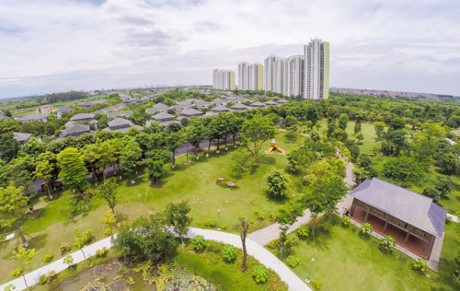 Ecopark, an urban township on the outskirts of Hanoi, is highly appreciated as a green project. (Photo: Hai Anh/Internet) Ecopark, an urban township on the outskirts of Hanoi, is highly appreciated as a green project. (Photo: Hai Anh/Internet) |
The first green works in Vietnam were built in 2007 and were enthusiastically welcomed by the government, and the general public. In the following decade, 60 construction projects in Vietnam have been certified internationally as green works.
Architect Hoang Thuc Hao, a lecturer at the National University of Civil Engineering, says green works have been considered the right development direction because they conserve energy, preserve natural landscapes, and promote a healthy environment.
“Vietnam has traditional architecture works that save energy. For example, the 5-chamber houses in the rural area of the Red River Delta are constructed with organic materials in a north-south orientation, link gardens, ponds, and pigsties, and have front eaves made of timber, rocks, or soil. These are environmentally friendly materials. These houses are warm in winter and cool in summer. Our ancestors’ experience in architecture should be respected in modern architecture by combining advanced technology with native Vietnamese culture,” said Hao.
In the past decade, Vietnam’s annual construction and urbanization rate grew 12% and 3.4% respectively.
Energy consumption has increased 14% per year, growing faster than GDP.
Vietnam uses 36% of all its consumed energy for construction works, 33% of which is electricity consumption. This produces 25% of all greenhouse emissions and one third of all carbon dioxide output, the main contributor to global climate change. It is predicted that Vietnam will suffer severe ecological damage if it doesn’t take appropriate steps now to boost green works and conserve its natural resources.
Phan Thi My Linh, Deputy Minister of Civil Engineering, said the development of green works is part of the implementation of the National Green Growth Strategy.
She said: “We have defined green works as green architecture adapted to climate change. This means choosing the right scale and increasing the use of wind energy, solar energy, and environment-friendly materials.”
Green works development has been combined with sustainable development of urban and rural environments.
Architect Nguyen Thanh Le, Director of the 5.i.v.E Architecture and Construction Consultancy Company, said: “Green buildings must be environmentally friendly, so architects must pay attention to environmental issues from the original concept through the construction process. Because Vietnam has hot, humid weather, houses must be designed with modern technology, non-baked bricks, and double glazing. Ventilation must use convection to make the house cool and dehumidified. The house should be designed to take advantage of its own shadow to avoid direct sunlight, especially in summer.”
Vietnam can have more green buildings if the State, the public, architects, and builders all participate. The National Strategy on Climate Change and the National Strategy on Green Growth are the keys to promoting green works.
Professor Hao says the development of green buildings will bring great benefits to the national economy, society, and the environment. But Vietnam needs more qualified architects, he added.
“Architects, especially young architects, should lead the development of green buildings and convince investors to put money into these programs. When the idea spreads throughout the community, people will see the benefits of green buildings. If only one or two architects are involved, it will be hard for them to have an impact. But if 100 to 200 architects join the movement, there will be a major breakthrough,” Hao noted.
Although the development of green works in Vietnam is relatively new, it has achieved positive results. The Vietnam Real Estate Association has set up a Green Building Program Coordination Committee comprised of architects, builders, and experts to provide a foundation for the development of green buildings in Vietnam.